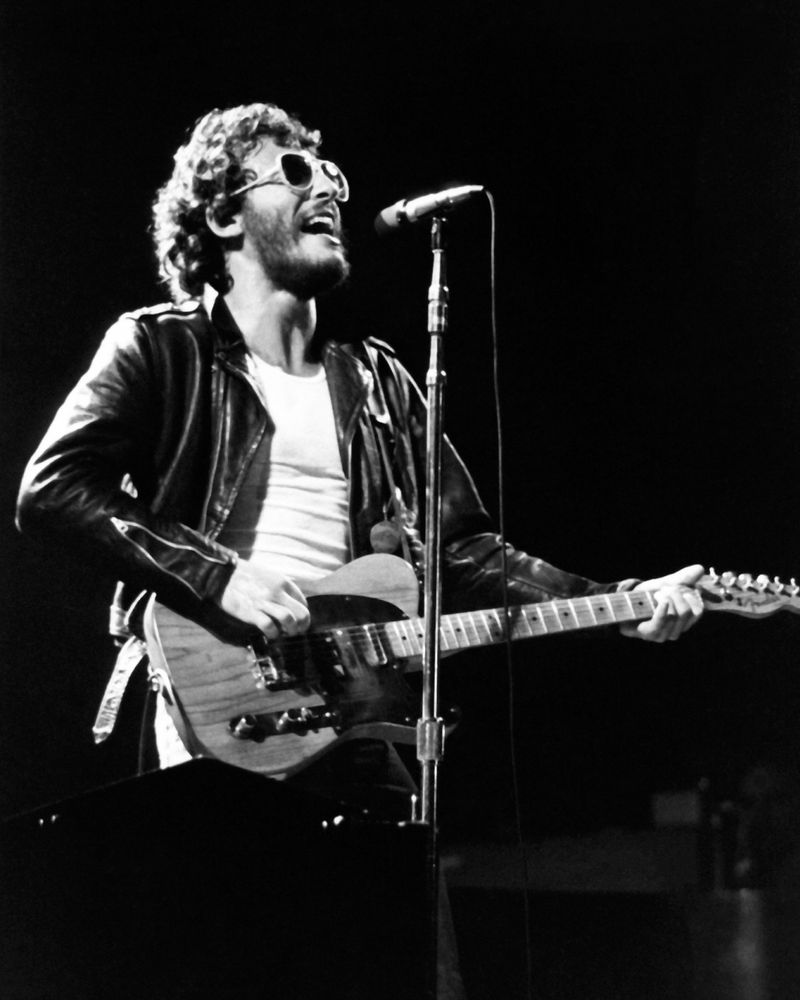THE JOURNAL

Bruce Springsteen in Holmdel, New Jersey, 17 October 1979. Photograph by David Gahr/Getty Images
In the trailer for the new Bruce Springsteen biopic Deliver Me From Nowhere, Springsteen – or Jeremy Allen White, who plays him – is shown buying a new car. “I do know who you are,” says the salesman. “Well, that makes one of us,” quips Allen White. It’s a clever way to breadcrumb the story, which focuses on an introspective Springsteen making 1982’s Nebraska, the album between The River in 1980 and 1984’s megahit Born In The USA. But it could also refer to the star’s style.
If he’s known for the Americana of the latter album, Deliver Me From Nowhere is an exploration beyond jeans and bandanas, with Allen White wearing plaid shirts, white T-shirts and a vintage leather jacket. Much in the same way that Timothée Chalamet as Bob Dylan put Dylan’s 1960s look on the radar of a new generation with A Complete Unknown, Allen White – another It-boy of 2025 – is set to add Springsteen to the mood board of American classics.
Professor Andrew Groves, the director of the Menswear Archive at Westminster University, says Springsteen has all the ingredients to sit in the lineage of style icons such as James Dean, Marlon Brando and Steve McQueen. “Springsteen represents the idea of the American everyman,” he argues.

Springsteen in London’s Hyde Park, June 1982. Photograph by Ilpo Musto/Alamy
The white T-shirt, a through-line between Springsteen and these movie stars, is central. “That garment allowed [Springsteen] to embody the positive tropes projected onto the working class – hardworking, honest, upright.” (Note: it works for Allen White, too, as Carmy Berzatto in The Bear).
Zak Maoui, the style director of Gentleman’s Journal, has written about Springsteen in the past. He believes the Boss’s style is ripe for exploring. “I think people look instead to the obvious guys – David Bowie, Alain Delon and Robert Redford – when they think of 20th-century style icons,” he says. “Springsteen gets overlooked. You never really hear of people discussing his style, but it was all there. The camp collars, the leathers, the tight tees and vests.”
If it’s based in American workwear and pays homage to the men who wore these clothes, the Springsteen formula works beyond just one demographic now. Look at any slideshow of archive images and you’ll see a masterful take on familiar staples: scuffed black jeans, shirts draped just right and, of course, rock-star sunglasses.

Springsteen in 1979. Photograph by Vinnie Zuffante/Getty Images

On stage during the Lawsuit Tour at the Santa Barbara Bowl in Santa Barbara, California, 5 October 1976. Photograph by Lester Cohen/Getty Images
Then there’s the stage wear in the late 1970s and early 1980s – suave, but never formal suits, patterned shirts, or artfully worn leather jackets. It’s also worth considering previously dismissed eras. In July, GQ asked “Was Bruce Springsteen’s 90s Style Actually Great?”, pointing to open-necked shirts, a leather trench and those classic jeans.
Hannah Summers, co-founder of London’s Springsteen-dedicated club night, Hungry Heart, says this is in line with the fanbase, who go beyond the Born In The USA look. “Leather jackets, beanie hats, checked shirts [are the favourites] – depending on the era,” she says. “He also has a tour ‘uniform’ that tends to be a dark shirt, dark waistcoat, jeans and boots – a look I associate him with now, too.”
Maoui, meanwhile, appreciates a specific shot. “There’s an image of him in a red T-shirt on stage at the Palladium in 1976 in New York,” he says. “It’s a tight T-shirt that reads ‘Town & Country Cycle, Westwood NJ’. It was a little camp.”

Performing at the Palladium in New York, 30 October 1976. Photograph by Richard E Aaron/Redferns
Groves argues that the sheer simplicity of Springsteen’s look is something that’s likely to appeal now. “For many, there’s almost a political rationale and appeal in not dressing ostentatiously, and in aligning their clothing with the everyday dress of the everyman,” he says. As Springsteen-approved items are now staples in a menswear style lexicon, there’s plenty of options to consider. Think of Americana-adjacent plaid shirts from brands such as NN07 and CELINE, biker jackets from Rick Owens and Enfants Riches Déprimés or vintage-style rock T-shirts from KAPITAL.
“The Born To Run album cover [from 1975] was a classic Bruce look of the time,” Summers says, noting what has, and hasn’t, changed with Springsteen’s style over the years. “Leather jacket and white tee. That has evolved to be a smarter version of the same – in Letter For You [from 2020] for example, he’s still wearing a leather jacket on the cover.” And this may be a style lesson in itself: find your signatures and stick to them.
Of course, it’s not as simple adding something of his wardrobe into your own. In the wake of Deliver Me From Nowhere, we should brace ourselves for a cohort of Springsteen clones taking to the streets.
Maoui warns against looking to Springsteen’s look via Allen White because it’s too cookie cutter. Instead, go a bit deeper. He points to what Allen White – following Chalamet’s cue with Dylan’s style during the press tour for A Complete Unknown – wore to the New York premiere: “a leather blazer that was a nod and throwback to Springsteen’s [1990s] style”.
The best strategy, then, is to take Springsteen’s way of dressing as a jump-off point, rather than attempting a facsimile. “[Springsteen’s style] wasn’t polished and that’s what made it so good,” Maoui says. “It was inherently his own – a mishmash of genres.”
“Keep it simple, stick to staples, don’t try to match everything,” Groves says. “The point is to look unplanned, not curated.”
The people featured in this story are not associated with and do not endorse MR PORTER or the products shown